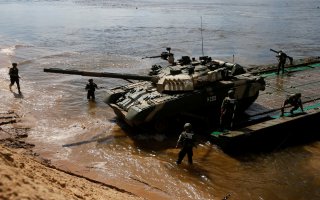Russia's T-80 Tank: Invaluable Weapon or Outdated Relic?
Despite its age, the T-80 likely isn't going anywhere.
Key Point: Upgrades willl likely continue for years to come.
Sure, the T-14 Armata is cool, but have you heard of the T-80 series? On paper at lease, it packs a mean punch.
The crowning achievement of the T-80 was its multifuel gas turbine engine. In a way, it was a success. Rather than the as-per-usual Soviet mistake of decidedly underpowered tanks driving off the assembly line, the T-80 came standard with a very powerful 1,250 horsepower under the hood.
Extremely agile, the T-80 series was perhaps the most nimble Soviet tank ever produced, and had a very high weight-to-power ratio.
According to some sources, in the event of a war with NATO, T-80s would be able to reach the English channel in less than a week — only five days — if they could only sustain their supply lines and manage to not run out of fuel.
But there was one big problem. The T-80s guzzled more gas than your crazy uncle Rick’s Hummer. Their fuel consumption was a huge logistical problem.
However, in tandem with production facilities in Russia, facilities in Ukraine developed a different version of the T-80 — but with a more conventional diesel engine. While less logistically flexible than a multi fuel turbine engine, and with slightly less power output, the traditional diesel alternative meant that the Ukrainian-developed T-80s had much higher fuel efficiency.
These Ukrainian T-80s continue to be updated, and even exported, to Cyprus and Pakistan, and form a key portion of Ukraine’s armor.
Chechnyan Roman Candles
The T-80 series first saw extensive combat during the First Chechen War, although their use — and losses — remain controversial.
Relatively compact, the T-80s are not particularly suited to urban combat, partly due to their long, overhanging main gun, which is less maneuverable in tighter and more confined urban spaces.
T-80s in Grozny suffered unusually high losses for what was touted as a modern, capable Main Battle Tank. Part of the problem was Grozny’s defenders. It is reported that many of the defenders were veterans of the Soviet-Afghan War, experience veterans rather than young, inexperienced volunteers.
Which was exactly what a number of the T-80 tank crews were made of — young conscripts that were poorly trained. In the years following the collapse of the Soviet Union, Russian military funding was quite insubstantial. Training and preparedness consequentially suffered.
Compounding the training problem was the fact that many T-80s had apparently not been outfitted with Explosive Reactive Armor (ERA) inserts that would have in theory protected them from a rocket-propelled grenade and other anti-tank fire.
Pipe Dreams
Another problem was the powerful — but dangerous gas turbine engines.
Just prior to the Second World War, Russian military observes had noticed that in skirmishes with Japan their gasoline-fueled tanks suffered an outsized number of losses due to catastrophic explosions caused by gasoline engines catching fire after indirect hits.
This design consideration resulted in a strong reliance on less explosive — and safer — diesel fuel engines. Unfortunately for the T-80 crews in Grozny, this consideration was forgotten, and a number of catastrophic explosions were recoded.
New Lease on Life?
Despite the T-80 series vulnerabilities — and extensive losses — they remain in the inventories of both Ukraine and Russia, where upgrades to armor and fire control systems will likely keep them rolling along for years to come. Who says the T-80 series is history?
Caleb Larson is a Defense Writer with The National Interest. He holds a Master of Public Policy and covers U.S. and Russian security, European defense issues, and German politics and culture.
This article first appeared earlier this year and is reprinted due to reader interest.
Image: Reuters

